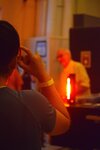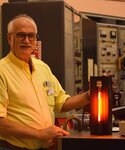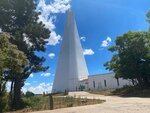Wind: 10.4 mph, N
Welcome to our new web site!
To give our readers a chance to experience all that our new website has to offer, we have made all content freely avaiable, through October 1, 2018.
During this time, print and digital subscribers will not need to log in to view our stories or e-editions.




“Telescopes play with rainbows,” says volunteer Bill Wren to a dimly lit room packed with visitors of Sunspot Solar Observatory near Cloudcroft. The crowd is comprised of both young and old tourists who’ve flocked to the observatory to tour one of the world’s greatest solar telescopes, the Richard B. Dunn Solar Telescope (DST), operated by New Mexico State University. Their eyes remain fixed on the slide show Wren has put together to illuminate the information he shares about the telescope, the sun, and our long plight to fully understand its marvels.
Wren flips through screens depicting explosive coronal mass ejections, hot gas brimming on the sun’s atmosphere, light spectrums, and the immensity of the Sun compared to the planets which orbit it, including ours.
“It’s incredible, folks,” Wren said, explaining the connection between ancient solar science and modern technological innovations, like the DST.
Wren, who is recently retired from McDonald Telescope in Texas, worked a long career as a public information specialist – and eventually as special assistant to the superintendent – for more than 30 years. He was responsible for leading educational outreach programs at the observatory, but his career offered him many other exciting opportunities, including working alongside astronomers, studying distant celestial objects, building telescopes, and promoting the value of dark skies to oil and gas companies. Even now, in his retirement, Wren finds himself drawn to supporting public education efforts, which is why he reached out to Sunspot Solar Observatory after moving to Cloudcroft in 2021.
“I was an academic tutor for astronomy,” Wren said. “I just enjoy teaching people about astronomy, because I find it so fascinating. Happily, [the people at Sunspot] said ‘sure!’ They basically gave me the freedom to do it how I wanted to do it, so I do what I learned when I was at McDonald. I prime [the visitors] to see the telescope, help to facilitate the tour, and then I do the spectroscopy demonstration.”
During Wren’s presentation, visitors learn about the physics of the sun, a brief history of astronomy, and the unique history and features of the Dunn Solar Telescope – which Wren educated himself on before beginning his program.
“The Dunn Solar Telescope is just really amazing,” he said. “It’s such a neat telescope. I feel very fortunate to be able to show people around there. And trying to explain how spectroscopy works there is great.”
Originally called the Vacuum Tower Telescope (VTT), the Dunn Solar Telescope is regarded as one of the best solar facilities in the world. Using its vacuum tube light path, the telescope essentially “smears sunlight out into its constituent colors and onto the optical bench,” Wren said, “which allows astronomers to use a variety of instruments to study sunlight.”
It was renamed in the 1990s to honor astronomer Richard B. Dunn, who helped determine some of the defining features of the telescope, including its rotating floor, which helps the telescope rotate as the sun rotates.
“If [the telescope] didn’t rotate, the image would slowly turn and blur,” Wren said. “By rotating the telescope, you de-rotate the image of the Sun.”
For the past year, Wren has spent his free time spreading this knowledge with tourists. He conducts the programming at Sunspot Solar Observatory on the first Saturday and Sunday of every month, helping to facilitate a tour of the DST facility as well as performing a spectroscopy demonstration, which is an area of astrophysics that has always amazed him.
Astronomy became astrophysics when you could use spectroscopy to decipher the chemistry and the physics going on at the source of your observation, Wren said.
Wren likes to share this kind of knowledge and history with others to express how amazing it is that we have come so far with the technology needed to study the sun, stars and distant celestial objects.
Spectroscopy, the study of light according to color, is an area of astronomy Wren has been exploring and demonstrating to the public for years. In his program at Sunspot, The National Solar Observatory, he likes to incorporate this intriguing and beautiful piece of science as a way to give visitors a hands-on experience.
“One of the programs I developed while working at McDonald was a spectroscopy demonstration using handheld diffraction gratings that show the emission lines for different chemical elements,” Wren said. “Being able to show people that you can identify different chemical elements from a distance because they emit and absorb light at particular colors is quite rewarding. When people wonder ‘how do you know what it’s made out of or how hot it is,’ the answer to all those questions is in the technique of spectroscopy.”
Inside the Dunn Solar Telescope facility, visitors gather in the dark to participate in their own spectroscopy experiment. Using tubes of different chemical elements like mercury, hydrogen and neon, Wren shows how each element gives off their own unique color patterns on the spectrum. Looking through special lenses called transmission gratings, visitors can see for themselves the varying wavelengths, visualizing how astronomers are able to decipher what chemical compound makes up an object they are viewing from lightyears away. This is one of the reasons Wren finds that combining the history of astronomy with a spectroscopy demonstration is so vital to the public’s understanding of astrophysics.
“That is what makes all science valid” he said. “It can be recognized as fact and as truth because anybody can perform the same experiment and come up with the same results with the proper equipment. You don’t have to take my word for it. You can see it for yourself.”
The visitors become part of the experiment. They are participating in the same observation that has been performed by scientists for decades, connecting with them as much as they are with the marvels of the universe.
“I often hear that looking through a telescope makes someone feel so small, you know? Like, they’re just this tiny little spec in the corner of this vast universe,” he said. “And while that may be true there is also this sense of being connected, that you’re participating in this scheme of things.”
Once the tour ends, visitors are free to roam the grounds, explore the other solar facilities – which have been decommissioned in recent years – walk the trails, and check out the gift shop and museum. Wren believes the work astronomers do helps people understand their place in the cosmos.
“I strongly believe in emphasizing the difference of ‘having been placed into the universe’ and ‘being a product or participant in the larger universe’,” He said. “It helps provide me with a sense of connectedness. It’s a kind of mystical thing.’”